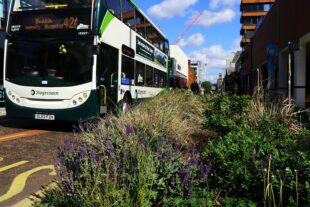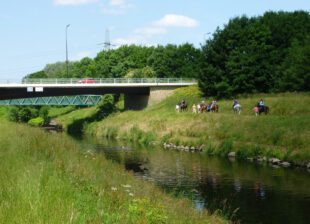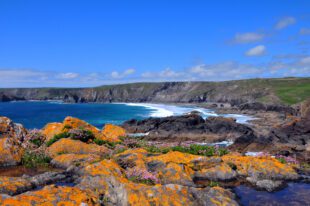Local Nature Recovery Strategy Pilots
Local Nature Recovery Strategies (LNRS) are a flagship measure in the Environment Bill. They are a new system of spatial strategies for nature which will plan, map, and help drive more coordinated, practical, focussed action and investment in nature’s recovery to build the national Nature Recovery Network.
I’ve been lucky enough to lead the Local Nature Recovery Strategy (LNRS) pilots for Natural England, working with Cornwall Council, Greater Manchester Combined Authority, Buckinghamshire Council, Cumbria County Council and Northumberland County Council. Throughout, their fantastic interest and commitment has impressed, encouraged, reassured, and inspired me in equal measure.

Their positive and consistent engagement to explore and challenge this new policy, sharing insights with us over the short nine months of the pilots’ duration convinced me LNRSs are the natural next step in establishing a locally owned and strategic way to plan nature recovery. The more I understand about LNRSs the more significant, and game changing I think this legislation will be. This is the first time we are putting planning for nature recovery on a statutory footing! LNRSs will drive action for nature recovery to grow and develop our national Nature Recovery Network. This is our most important policy goal.
Such significant change and at this scale is not straightforward, and will require a tremendous amount of working through together, but what a great start we’ve made through the pilots.
Some people involved with biodiversity opportunity mapping felt the LNRS process was familiar. In some ways it is, but there are critical aspects that are different such as a broader focus to include wider environmental benefits and the collaborative and the community engagement aspects. Responsible Authorities (RAs) need to keep these differences central in their approach to putting an LNRS delivery team together making sure they line up the right skills and project management.

Linking into existing networks reduces the need to build new relationships. This was particularly true where the Local Authority and Local Nature Partnerships have a good track record of collaboration. Again though, this new collaborative approach requires inclusion of the widest range of stakeholders. These include local rural and urban communities, the farming community, plus biodiversity and natural environment experts. LNRSs will link people to places and will investigate how the climate and biodiversity crises impacts them, enabling them to work together to explore priorities and agree what measures can be taken.
Tensions were inevitable, and not all were resolved within the pilot time frame. These highlighted both the need for independent facilitation to handle difficult conversations, and the importance of partnership working, good governance and clear remits.
Lessons Learned
Rattling along with our pilots, the biggest lessons for me are:
- LNRSs really are new. They can look very familiar in places, especially in the evidence and mapping. But there are significant differences:
- shifting decision making for nature recovery to political administrative boundaries, to align with land use planning
- bringing together planners, LNPs, farmers, protected areas, the public, eNGOs, ALBs and more to establish a locally led collaborative processes
- coordinating and channelling effort in a strategy with a clear mandate that is understood by everyone with an interest; and
- LNRSs will inform two significant delivery mechanisms: biodiversity net gain and future agri-environment schemes.
The environment sector has an excellent track record in Biodiversity Action Planning and partnership working. Local Authorities and their partners will want to draw on these skills and expertise to create Local Nature Recovery Strategies.
- It’s not just about biodiversity. LNRSs are expected to include the wider environmental benefits of nature recovery, including nature-based solutions that counter the effects of climate change, such as natural flood management. The pilots have shown the potential for LNRSs to bring together land use planning and land management. For example, they’ve identified woodland to store carbon, reduce flooding and cool urban areas; and peatlands, which absorb then store water while capturing carbon dioxide, contributing to Net Zero targets. This and more can be achieved by joining up nature recovery with wider environmental outcomes.
- LNRS’s need transparency for collaboration, and consensus in decision making. We’ll need broader and more diverse stakeholder participation from the earliest stages in our LNRSs. Transparency in the production of LNRSs has been important to encourage participation, help resolve difficult or competing issues, and to obtain consensus among participants. The Pilots used decision making logs and tables for this.
- More data doesn’t necessarily equate to better LNRS. Understanding the purpose of each step in the process, and a line of sight to the end product or goal, will aid in the selection of relevant data necessary for LNRS mapping.
- We need to improve our understanding of how LNRSs connect to other plans and spatial strategies. These include: Local Plans and the planning system; Protected Landscapes Management Plans; River Basin Management Plans; Coastal Change MPA’s; Green Infrastructure; Delivery mechanisms such as biodiversity net gain, future agri-environment schemes and other new aspects of the Environment Bill, including the strengthened biodiversity duty in the NERC Act, Protected Sites Strategies and Protected Species Strategies.
See Defra’s lessons learned report for further information.

The LNRS Consultation
These have been, and continue to be, exciting times. With the public consultation now open which will inform the regulations and statutory guidance, that will implement LNRS across England, we need people to think about what it will mean to our communities to plan strategically and collaboratively for nature recovery at such a scale and consistently across the whole of England. This includes thinking of LNRSs as a new way of working, that brings land use planning together with land management to drive action for nature recovery.
LNRS will develop our national Nature Recovery Network and deliver our most important policy goal, to become nature positive in this country. The positive lead given by the pilot Local Authorities leaves me excited to see how we all respond. The Defra led LNRS consultation is the next very important step in this journey. Please take this opportunity to respond and shape the future of nature recovery in this country.
The consultation will close on Tuesday 2 November. Please do submit your consultation response using the online survey provided on Citizen Space.
2 comments
Comment by Bill Grayson posted on
Is the LNRS directly linked to the Local Nature Recovery actions being devised as part of ELM? And I see mention here of the term 'land use planning' which is something that I, as a land manager, was not aware of. Please could you refer me to some further guidance as to what this means and how it will work.
many thanks
Comment by Oliver Baines posted on
Hello.. there has been some really good work on the LNRSs. However we need to bear in mind that it's not policies and programmes that make the difference, it's people: and we need a cultural shift amongst policy makers, opinion formers, councillors, farmers and local residents that looks on the biosphere as our companion and its inhabitants as fellow travellers, not as irritants, obstacles or enemies. A chemical spray needs to be a tool of last resort; a field needs to be a haven for nature from which we borrow a part to grow our food in. And I say that as a farmer and a member of an LNP!